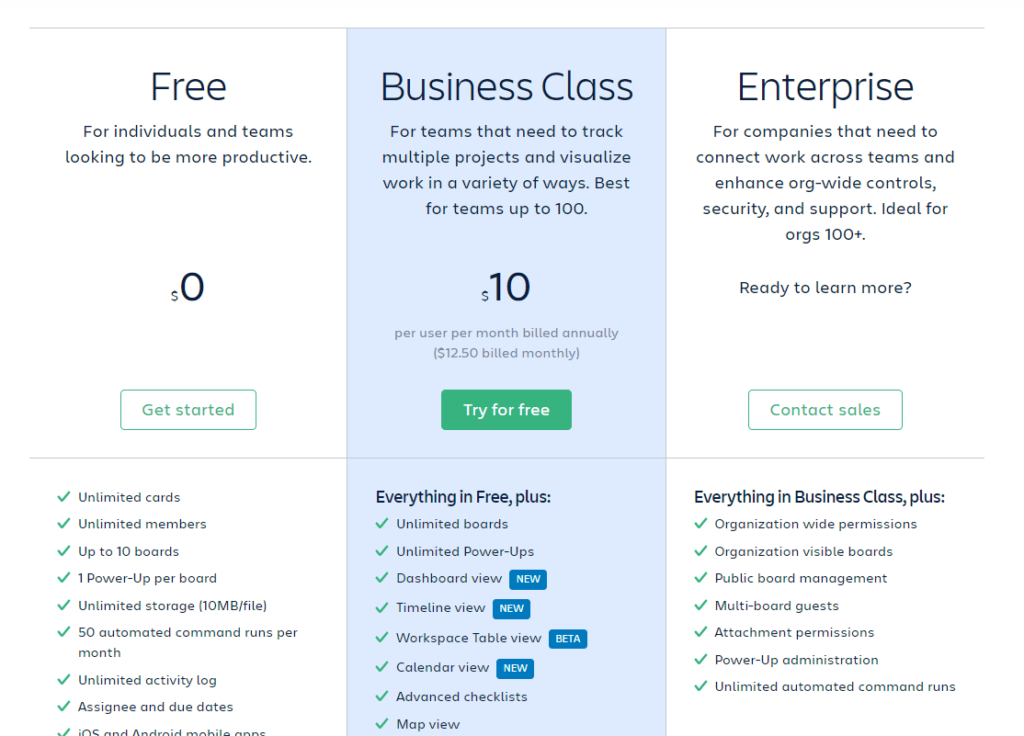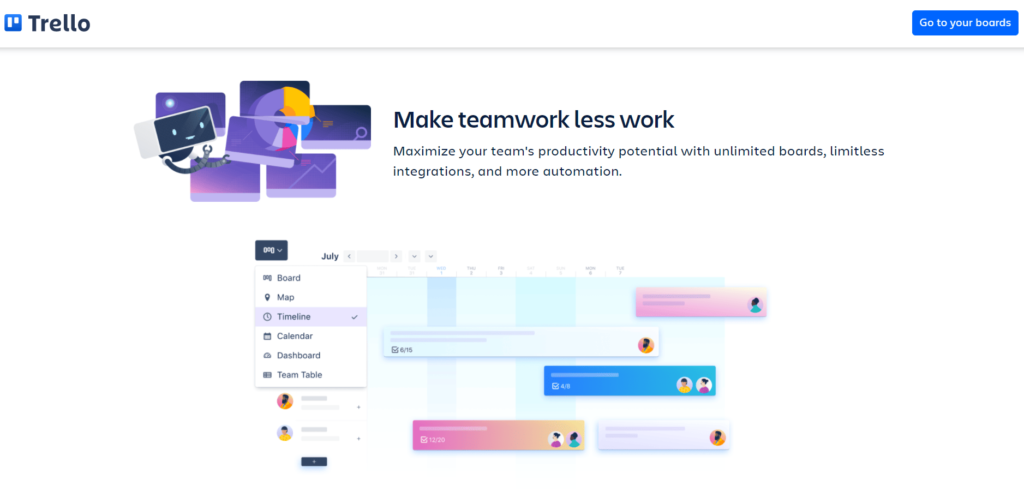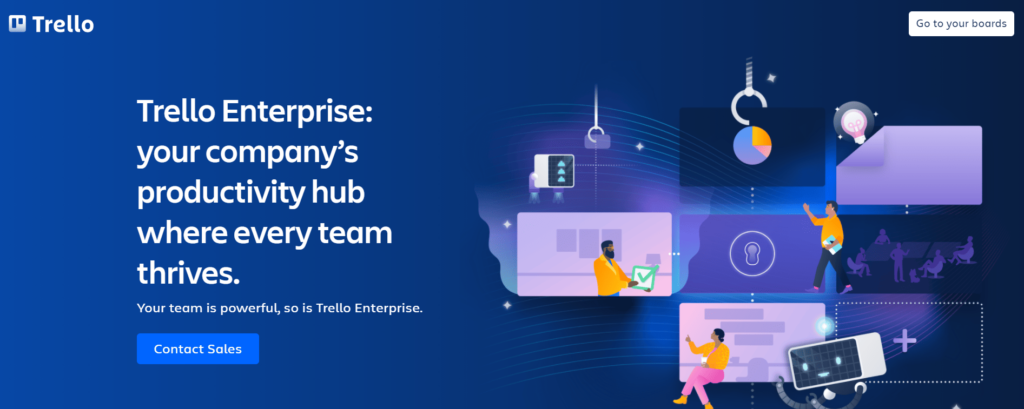Disclosure: This content is reader-supported, which means if you click on some of our links that we may earn a commission.
If you’re a fan of simplicity, Trello is the most user-friendly project management solution—it’s also what we use every day. Its intuitive and familiar drag-and-drop Kanban-style task management interface helps everyone on the team visualize task progress throughout the pipeline. It’s dead simple to use and has an excellent free plan, but it’s missing more advanced functionality and may feel too limiting for complex projects. We wrote this Trello review based on our experiences to give you an inside look and help you make the best choice for you and your team.
Compare Trello to the Best Project Management Software
Because of its simplicity and focus on ease-of-use, Trello slid into the #3 spot on our list of the best project management software. And it’s our top pick if you want to get started in the next five minutes. Yep—it’s that easy. We use it every day, and it keeps our entire team in the loop with all of our linear, ongoing, and straightforward tasks at various stages in the pipeline.
While it certainly reigns supreme for simple projects, it’s one of many excellent options out there. Because of that, it may not be the ideal solution for you and your team, depending on what you do. Looking for something a bit more comprehensive with advanced functionality or want to explore all of your options? See all of our top picks, here.
Trello: The Good and The Bad
The Good
Easy to Use: Trello’s usability is one of the platform’s primary highlights. It’s as intuitive as it gets, which is one of the reasons why it’s such a great solution for smaller projects and teams. Even non-technical users can navigate the platform without any hassle or headaches. From starting a new project to onboarding new team members, everything is so straightforward. There are only a handful of potential actions you can take on Trello, so there’s virtually no learning curve. You could sign up now and set up a new project board in minutes.
Workflow Automation: Even for a simple solution, Trello has built-in tools for automation. For your most important and repetitive tasks, you can create rule-based triggers using Butler, Trello’s automation bot. Butler is designed to eliminate tedious tasks from your team’s to-do list. It’s perfect for setting up due date commands, calendar commands, and custom buttons. For example, you could create a custom button that automatically moves a card from one list to another and then assigns it to a new team member once a particular action has been completed.
Extended Functionality Options: Trello is fairly basic out-of-the-box. But you’ll have the opportunity to extend the platform’s functionality with “Power-Ups.” You can integrate tools that your team is already using—like Slack, Google Drive, and Microsoft Teams—into your Trello workflow. You can find Power-Ups for file management, communication, analytics and reporting, and more. These extended capabilities help take a basic Trello board to the next level.
Powerful Mobile App: Most of the best project management solutions come with some version of a mobile app, but Trello’s is a fan favorite. It’s a perfect way for team members and project managers to work on-the-go. The same functions from the web-based platform are accessible from the mobile app. So if you’re on the go and need to quickly respond to a team member’s question, you can handle everything from the palm of your hand.
Team Collaboration Features: While Trello doesn’t come with team chat or anything like that, it’s still a simple solution for team collaboration. It’s easy for project managers and users to assign cards to different team members. Each user can comment on cards and tag team members to ask questions. When tagged, the person gets notified via desktop notifications, push notifications, or email. Plus, it gets even better if you integrate Trello with Slack or another team chat platform.
Great Value: Trello’s price point is very appealing. There’s even a free forever plan that comes with unlimited cards, unlimited lists, and up to ten boards per team. If you upgrade to a paid plan, you’ll benefit from unlimited boards per team and a ton of other features. With rates starting for less than $10 per user, the platform really delivers. We’ll discuss these exact plans and rates in greater detail shortly.
The Bad
Limited Project Views: Trello’s entire platform is based on Kanban-style boards. It doesn’t come with Gantt charts, timeline views, or Scrum boards for agile sprints. The Kanban boards are fine for small projects, but software teams and organizations using advanced agile project management methodologies might find Trello a bit limiting.
No Reporting: Trello doesn’t come with reporting and analytics out-of-the-box. So managers can’t use this software to see how well their team performs or get actionable insights related to projects at a higher level. You can add reporting tools by using a Trello Power-Up, but it’s not quite the same as having a project management tool with built-in reports.
Not Ideal For Complex Projects: Again, Trello is a great option for simple projects. But if your team has advanced needs, then Trello might miss the mark for you. You can’t attach tasks to subtasks and see a holistic view of how one delayed task will impact others in the queue. For something advanced like agile project management for software developers, Trello probably isn’t the best choice.
Trello Pricing and Options
Trello Pricing
As previously stated, Trello is one of the most affordable project management tools on the market today. There’s even a free plan for basic use. However, the paid options deliver tremendous value for teams of all sizes. Get a free demo of Trello to find the right plan for you.
Here’s a closer look at Trello’s plans and pricing options:

The free plan is great for personal use and small side projects. It comes with unlimited cards, unlimited lists, and 10 MB per file attachment. This package only supports up to ten boards per team, but that’s usually more than enough for personal use.
Trello restricts users on the free plan to just one Power-Up per board. So you won’t really be able to extend each board’s functionality much beyond its standard capabilities.
Surprisingly, the free plan does support automation. Most project management tools don’t offer automated functionality at a free level, so it’s nice to see that Trello does. However, the automation tool is limited to just 50 butler commands per month.
Compared to alternatives on the market, Trello’s free plan is arguably the best one. But it is a bit limiting beyond personal use. For business use and teams larger than just a few people, you’ll definitely want to upgrade to a Business Class or Enterprise package.
You can try one of Trello’s paid packages for free with a 14-day trial. It’s also worth noting that Trello offers discounts for educational institutions and nonprofit organizations. So if you fall into one of those categories, contact Trello for custom discounted pricing.
Trello Business Class
Trello Business Class is the platform’s entry-level paid pricing tier. It’s the most popular product offering from this provider. With rates starting as low as $10 per user per month, it’s still a bargain and a great value for teams of all sizes.
As the name implies, Trello Business Class is designed for work-related project management. If you have 10, 20, or 30+ team members, you’ll definitely want to upgrade to this package. It’s also a great option for organizations with several departments that need to manage multiple projects simultaneously. While the free package only supports up to ten boards per team, Trello Business Class offers unlimited boards.

This product comes standard with advanced features and Power-Ups, including custom fields, calendar and map views, advanced checklists, list limits, card repeaters, voting, and over 100 app integrations.
If you want to get the most out of Trello’s butler and its automation capabilities, you’ll need a Trello Business Class subscription. There are still some restrictions, but it’s more than enough for most teams. You’ll get up to 1,000 command runs per team plus 200 per user with a maximum of 6,000 command runs per month. Most teams, especially small teams running simple projects, won’t come anywhere near these limits.
Overall, if you’re comparing Trello Business Class with other Kanban-style project management tools for less complex projects, this is the industry leader.
Aside from Kanban view, Trello recently added calendar, dashboard, timeline, map, and workspace table views to help you get the visibility you need at a glance—whatever that looks like for you.
If you’re planning on using Trello beyond personal use for a side project, go with Trello Business Class. This will help put you and your team in a position to succeed.
Try Trello Business class for free by signing up for a 14-day trial.
Trello Enterprise
Trello Enterprise is the top-of-the-line product offering from this provider. It’s designed for larger teams with more advanced needs for project management.
The software starts at $17.50 per user per month, but Trello offers volume discounts for larger teams with more than 250 users. For example, the per-user rate drops to $16.25 per month at 500 users and goes all the way down to $7.38 for 5,000 users.

It’s worth noting that Trello Enterprise doesn’t necessarily accommodate more advanced projects. The software simply adds functionality to simple projects on a larger scale. This is especially true for automation. With Trello Enterprise, you’ll benefit from unlimited command runs across your entire team.
The Enterprise solution also comes with the ability to control content management permissions and manage users in real-time. All of this can be handled with just a few quick clicks. The administrative controls for the Enterprise package are far superior to the Business Class product. This solution comes with enterprise-grade security and reliability, including a 99.999% uptime commitment.
Some of the other noteworthy features that are only available on Trello Enterprise include:
- Data encryption with hourly backups and off-site storage
- Organization-wide access restrictions at team and board levels
- Attachment restrictions and file sharing preferences
- Membership controls
- Control which third-party Power-Ups can be integrated with boards
- Top-tier enterprise support
Overall, Trello Enterprise is perfect for larger organizations and administrators who want more control over what happens with their team’s boards. It’s also a viable option for Business Class users that are reaching monthly limits with butler automations. But Trello Enterprise is still designed for simple projects. So don’t try and do anything too advanced here.
Contact the Trello sales team to get started with an Enterprise plan.
Trello Gold
Trello Gold isn’t a traditional package or subscription level. It’s essentially a user badge that falls between the free and Business Class plans. If you’re using Trello for free, you can get Trello Gold to remove some limitations and restrictions.

For just $5 per month, it’s a bargain. If you know that you’ll want to use Trello Gold for an entire year, pre-pay annually and get three months for free. This is less than half the cost of a Trello Business Class plan.
Here’s what you get with a Trello Gold subscription:
- Up to three Power-Ups per board (instead of one Power-Up with the free plan)
- Custom backgrounds, stickers, and emojis
- Premium stickers
- Attachments up to 250 MB (instead of 10 MB attachments with the free plan)
- Saved searches
- Advanced automation with custom buttons, schedule commands, and Butler rules
Anyone currently using Trello for free should consider using Trello Gold to get the most out of this platform. Especially if you want to upload large files, use more Power-Ups, and leverage automation.
You can get Trello Gold for free by recommending your friends to sign up as well.
Comparing The Best Project Management Software
Check out our top picks of the best project management tools to see some popular alternatives to Trello.
- Monday.com – Most versatile project management software
- Asana – Best for small to midsize remote or distributed teams
- Trello – Best project management tool for small projects
- Jira – Best project management system for agile teams
- LiquidPlanner – Best project management software for large teams
Trello is a top project management solution for small projects. It’s not quite as feature-rich as some of the other tools on the market today, but it’s more than suitable for simple projects. If your team has advanced needs for complex projects, you can find a Trello alternative from one of our top recommendations listed above.

